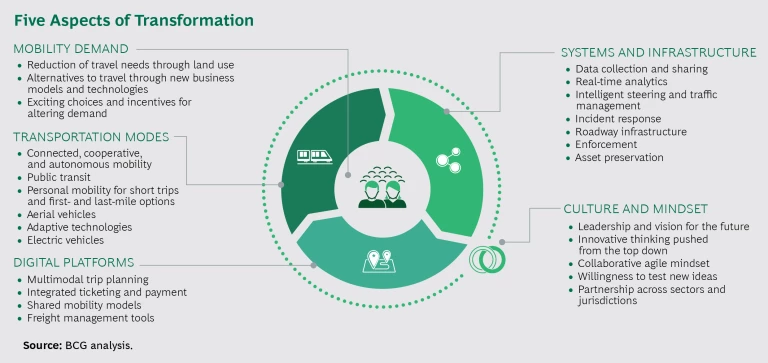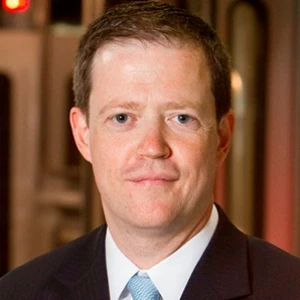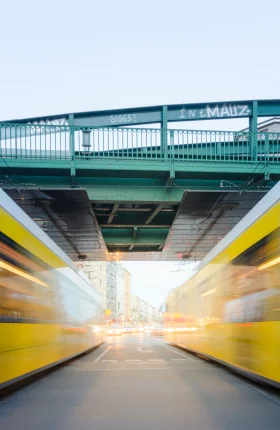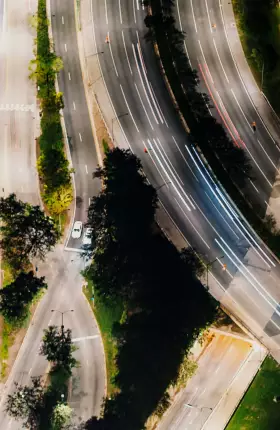Smart sensors, ridesharing apps, big data, and other technologies are widely recognized as keys to unlocking congested urban transportation systems. Yet even with many of these tools in use, we’re stuck with gnarled city freeways and overstretched transit systems.
Technology alone is not the solution. Harnessing the real power of innovation lies in deploying the agile approach. Holistic, collaborative, and driving change through the rapid piloting of ideas, the agile methodology—which has proved successful in industry—should now be applied to easing our worst transportation bottlenecks.
The urgency of doing so is undeniable. The world’s urban population is expanding rapidly. By 2045, it will have grown (by a factor of 1.5) to 6 billion, according to the World Bank. And as urban populations expand, so does the demand for mobility. The World Bank expects passenger traffic to exceed 80 trillion passenger-kilometers by 2030—a 50% increase over the 2017 figure. Ensuring the safe, sustainable, and efficient movement of people—and the goods they rely on—is essential to healthy societies and economies.
This will not be easy. Building more roads or buying more buses is not a viable solution. The challenge is to rethink how and when roads and buses are used and what tools could optimize the system and reshape the way people travel—or make it easier for them to avoid traveling altogether. To shift demand, create viable alternatives to travel, and provide data that informs smarter decisions, mobility must be tackled in its entirety. An agile approach to transportation can save governments money, future-proof urban-mobility networks, and create transportation choices that underpin economic and social success.
Congestion and Megatrends Demand a Rethink
Urban mobility is already significantly limited and problematic in many cities and regions. Congestion means employees waste time either because they are stuck in traffic or because they must leave earlier and earlier simply to arrive at work on time. This waste of time not only lowers productivity. There are other economic costs as well. In 2017, according to transportation analytics company INRIX, congestion cost US drivers almost $305 billion, an average $1,445 per driver.
Public health suffers as congestion heightens stress levels, increases carbon emissions, and exacerbates air pollution (the fourth-highest risk factor in deaths worldwide). With insufficient supplies of affordable housing near job centers, low-income workers are forced to live far from employment opportunities and spend more time commuting. In addition, when a city gains a reputation for gridlock, it risks a negative impact on tourism.
Furthermore, new technologies generate new problems. E-commerce is driving up the number of delivery vehicles on roads. If not actively managed, autonomous vehicles (AVs) and ride-hailing services could lead to an increase in single-occupancy vehicle use and prompt a shift away from public transit. A BCG-supported impact study of an AV pilot launched in Boston in January 2017 found that AV shuttles could reduce the number of vehicles on the streets by 28%. However, if this change were to be counterbalanced by people moving from public transportation to personal AVs, the reduction would be only 11%.
Governments must also be prepared for shifts that will mean lower revenues and higher costs. Electric vehicles and more efficient cars will drive down gasoline tax revenues, and parking revenues are expected to fall with increases in ridesharing and the use of AVs.
At the same time, the costs associated with repairing and maintaining aging infrastructure are rising, and expanding cities are seeing growing demand for transportation. Such worldwide megatrends will exacerbate existing problems and intensify the pressure to rethink approaches to urban mobility.
Reshaping the Urban Journey
Conventional fixes—for example, adding capacity—are not sustainable solutions for addressing the growing pressure on urban mobility networks. Collaboration among the government agencies that operate and maintain the various parts of the system will be critical, as will partnerships with the private sector. To address these challenges and identify solutions, public agencies need to test ideas quickly, and their solutions should incorporate the lessons learned from both successes and failures.
In the exhibit below, we illustrate the five aspects of the transportation ecosystem that must be considered together to address urban congestion:
- Mobility Demand. For what reasons do people and goods need to travel?
- Transportation Modes. Which transportation modes—cars, bicycles, and public-transit systems—do people use?
- Digital Platforms. Which online platforms—including websites and mobile apps—and devices do people use to plan and access transportation?
- Systems and Infrastructure. What sort of physical and digital structures underlie the world in which people travel?
- Culture and Mindset. How can an agile approach—with pilots we can learn from—be applied to upgrading the transportation ecosystem?
Mobility Demand: Finding Alternatives to Travel. The sustainable alternative to adding capacity is managing demand. This means not just asking people to travel earlier or later to avoid peak travel hours but also creating new ways of working and consuming that inspire people to change where, when, and how they travel—or decide not to. Achieving this will require the collaboration of partners, including urban planners, property developers, and employers.
Schools, health care providers, employers, and real estate developers can work together to reduce travel time by offering such alternatives as mobile clinics at schools, telemedicine services, and home-based or remote office space. On-demand shopping and deliveries can reduce the number of vehicles on the roads if deliveries are coordinated and routes are optimized. In Queensland, Australia, for example, a flexible work center pilot program offered government employees a telecommuting option. Individual participants’ travel time was reduced by more than an hour a day, and 83% of users reported improvement in their sense of well-being.
Smart land use policies can reduce the need to travel. For example, transit-oriented and mixed-use developments cluster housing, shopping, and jobs around public-transit networks. Appropriate incentives and support are crucial for encouraging providers, such as minimalls and banking facilities, to locate their facilities close to residential areas and for employers to rethink the way employees perform their responsibilities.
Leisure is another area of focus. Recreation facilities such as parks, gyms, and jogging paths ought to be located near residential areas. Copenhagen’s Finger Plan concentrates growth along suburban, regional, and metro and light-railway routes, leaving green space undeveloped between the “fingers”—the transportation corridors that extend from the city center. The “station proximity principle,” which requires large new offices to be located near metro or railway stations, has resulted in more than 61% of jobs and 56% of residences being within walking distance of the stations.
Transportation Modes: Traveling Smarter. Combined with well-designed incentives, cutting-edge technologies can reduce congestion and move people around in environmentally sustainable ways. Using data from various sources, a tailored approach to public-transit planning is possible with, for example, services offered to specific regions at specific times and service frequency adjustments based on demand. This makes public transit smarter and more attractive, leading to less road traffic. Meanwhile, data analytics can optimize routes and schedules, enabling transportation networks to maximize the number of people they move.
In the long term, new forms of shared transport, such as AV vanpools for schools, will offer options that are more efficient than many current modes of transportation. However, if they are made more convenient and can accommodate diverse user needs, even existing modes can reduce reliance on single-occupancy vehicles. For example, if ridesharing services provided children’s car seats, parents would be able to avoid using a personal vehicle for trips with their children.
Expanding first- and last-mile options is also important. The convenience of shared and electric bicycles provided at bus stops and railway stations would encourage people to use public transportation even if their home is not near a transit hub. In March 2018, for example, the Vélib system (which has since been taken over by the Smovengo consortium) provided some 20,000 bicycles at more than 1,400 strategically positioned stations across Paris.
Digital Platforms: Creating Seamless, Shared Mobility. Technology—including websites and apps, as well as smartphones, laptops, and other devices—underpins reliable cooperative transportation. Digital services provide access to timetables, service updates, and disruption alerts and allow users to plan trips, make payments, and receive tickets across multiple operators and modes. Meanwhile, technology generates aggregated data that informs policy and operational decisions.
Digital services can relieve pressure on transportation infrastructure. For example, in Helsinki, regional authorities created a single digital interface that provides open access to data on traffic, maps, and transit schedules. This paved the way for Whim, a private company, to develop a hassle-free alternative to car ownership. The company’s subscription offering provides a seamless service across public-transit, taxi, and rental-car options.
Technology allows groups of people to coordinate their travel. Ridesharing, carpooling, and shuttle services to and from their destinations encourage people to leave their cars at home. In Boston, users of the Skedaddle bus service can crowdsource routes that other users can join, and they can travel routes that other users have created.
Digital services cut costs for travelers and increase the number of people using the same transportation modes. These services also meet the demand of consumers who want the same kind of access to transportation that they have to shopping and online entertainment—anytime, anywhere, and in a form that they can tailor as they like.
Systems and Infrastructure: Giving Data Purpose. Information is key to coordinating complex transportation ecosystems. Real-time data collection, aggregation, and analysis can promote efficiency across the system, particularly if information is shared between the public and the private sectors. This information builds a foundation for intelligent infrastructure and smart solutions, such as route optimization and dynamic tolling, for road and traffic management.
High-occupation vehicle (HOV) lanes increase road use efficiency, as do express toll lanes (ETLs). ETLs help accelerate travel times by adjusting pricing in response to demand and controlling the number of cars. Intelligent steering and management tools—such as ramp meters, variable message signs, dynamic pricing, and access restriction—facilitate real-time adjustments that maximize efficient road use.
Singapore, for instance, is using a wide variety of these tools, including dynamic road pricing (which allows for charging fees on the basis of factors such as vehicle location, time of day, and congestion levels) and smart parking solutions (such as real-time parking-spot-tracking apps with integrated payment functions).
Meanwhile, open data gives users accurate, real-time information that lets them optimize their public-transit use, increases train and bus reliability, and encourages developers, transit authorities, city planners, and logistics players to improve the travel experience. In London, a policy of open data has paid off: more than 11,000 app developers have registered for the data, and 42% of Londoners are now using more than 600 travel apps.
Culture and Mindset: Agile Approaches for Driving Meaningful Improvement. New technologies and innovative transport solutions are emerging rapidly, but these should not be implemented in isolation. Each is part of a coordinated approach to upgrading the transportation ecosystem. It is crucial to drive change by starting small, evolving over time, and building a variety of capabilities—both human and technological—to support this.
Leaders across the public and private sectors need to promote agile, innovative thinking and encourage the rapid piloting and testing of ideas. They should empower their teams and organizations to set ambitious goals and then track progress toward those goals. Cities such as Detroit have recognized this and are actively addressing it. (See the sidebar.) They are examining new and existing solutions critically and, when necessary, abandoning them. Piloting of ideas—not just talking about them—lies at the heart of agile. Some pilots may not be successful, but a focus on user impact allows for quick learning, iterating in cycles, and scaling.
Detroit: Office of Mobility Innovation
Detroit: Office of Mobility Innovation
With its roots in automotive innovation, Detroit is well placed to advance the mobility revolution. As part of a three-year journey, the city is launching an iterative process that will use scalable pilots to improve vehicle and pedestrian safety, increase mobility in low-density areas, and reduce curbside congestion caused by drivers searching for parking spaces.
Recognizing the need for a framework that will enable it to roll out and test pilots quickly and efficiently, Detroit has created the Office of Mobility Innovation to integrate new technologies and services with traditional public transit and infrastructure.
Moreover, Detroit is working collaboratively with corporate and philanthropic partners to shape strategy and investments, develop pilots, construct the business case, and measure results. As the city supports pilot execution, corporate partners will contribute both financial assistance and internal resources to help develop and implement pilot projects, and the community will be involved throughout the process.
A collaborative mindset is essential. Success will require breaking down public-sector silos and promoting cross-functional thinking. The agile approach should prompt the formation of partnerships across sectors, including private-sector organizations that have the ability to develop innovative solutions at scale. Collaborative working calls for clear frameworks and protocols for the governance of data privacy and information exchange, as well as for open communication, which ensures mutual understanding of success. In these crucial cross-functional collaborations, both the public and the private sectors need to be empowered to contribute.
No Need to Wait
Transforming an ecosystem as complex as the urban mobility network is tough. And in the US, the need for change comes as uncertainty rises over the extent to which municipalities and states can count on federal resources. However, the advantage of an agile approach is that it does not rely entirely on large-scale capital investments. Applying agile approaches to mobility challenges, decision makers can move quickly. Instead of planning for perfection, they can pilot ideas and learn from small-scale projects that can be improved over time. And the time to start is now.
Leaders should encourage a variety of stakeholders—government agencies, corporations, and citizens—to meet on a regular basis, delegating responsibility and empowering colleagues throughout their organizations to innovate and experiment. The collaboration of peers in the government and the private sector will ensure that solutions are integrated across jurisdictions.
By promoting transparency and soliciting the views of the public (users who have genuine interest in transportation services) on what does and what does not work, leaders can incorporate solutions quickly and support a shared vision. Both government and citizens will welcome pilots and understand if some fail. Still, to build public trust, it is critical to track whether experiments are adding value.
Of course, to do all this, governments must build up their capabilities. They may need to acquire new talent and work with private-sector partners not only to supplement their financial resources but also to help introduce agile tools and accelerate the process of innovation.
Decision makers must be ambitious in setting goals and prepare for the future before it rolls over them. Efforts that succeed will alleviate the pressure that has been mounting on transportation systems, enhance the economy, increase the ability to compete, and improve the health and well-being of citizens. There is no reason to delay or postpone action. By deploying an agile mindset, cities and regions can accelerate the pace at which innovation is translated into solutions and demonstrate that, in a matter of weeks or months, rather than years or even decades, the transportation ecosystem can be transformed.












